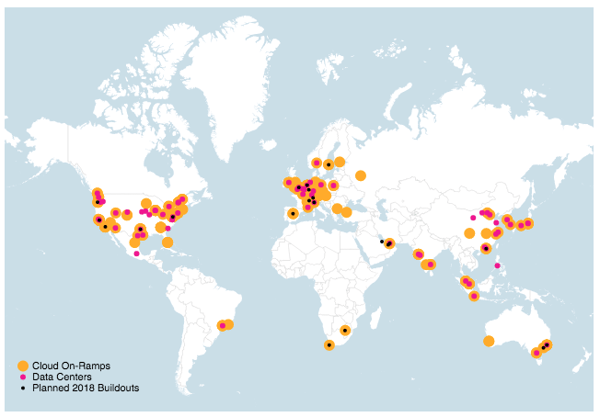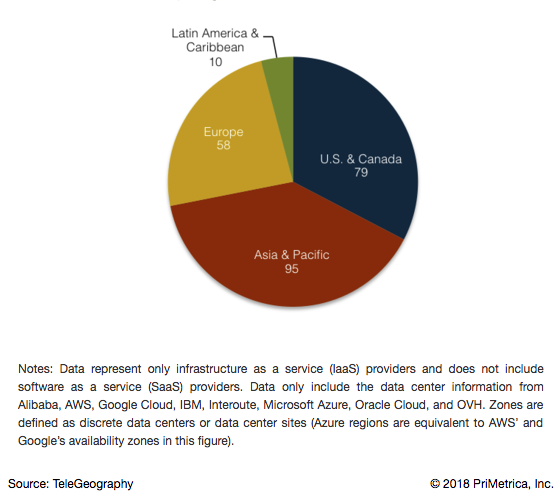TeleGeography’s Cloud and WAN Infrastructure details the international wide area network (WAN) services, cloud connectivity offerings, and cloud geographies of 170 WAN service providers.
Since the 2018 update is now available to our subscribers, we thought it would be a good time to take a closer look at who is connecting to the cloud and where cloud data centers are located based on our latest batch of data.
Who is Connecting to the Cloud?
Companies have traditionally connected to cloud services—which are increasingly critical for enterprise data management—via the internet.
And for many companies, public internet connections to cloud services remains sufficient. Those seeking better performance may peer with cloud service providers (CSPs), either through their network service provider or directly with the CSP if the company has an autonomous system number and meets the CSP’s peering requirements. For better security, companies may instead choose to connect via IPSec VPNs, tunneling through the public internet.
Other companies with high-capacity requirements and business-critical applications in the cloud, cloud services cannot be left susceptible to the performance of the public internet.
Other companies with high-capacity requirements and business-critical applications in the cloud, cloud services cannot be left susceptible to the performance of the public internet.
For these enterprises, cloud service providers and their carrier and colocation partners offer dedicated links to CSP networks. These links effectively extend an enterprise’s network into the cloud provider’s network, thus bypassing the public internet.
Global Cloud Data Center and On-Ramp Locations, 2018

The State of the Enterprise Service
Enterprise network managers have a wide array of service providers to choose from for a dedicated cloud connection service. While enterprises can set up a link directly with the cloud provider, more frequently a third-party—such as a carrier, colocation provider, or connectivity specialist—is used. Selection of a provider often depends on the location of the enterprise WAN in relation to the cloud providers’ zones or data centers.
If a company has routers located within the same colocation facility as the cloud provider, it can often work directly with the cloud service provider to facilitate the direct connection between the networks.
The Asia & Pacific region is home to the most cloud data centers (95). The United States and Canada region is not far behind (79).
The Asia & Pacific region is home to the most cloud data centers (95). The United States and Canada region is not far behind (79). Together these regions account for 72 percent of the world’s cloud data centers, with Europe housing 24 percent and Latin America just 4 percent. The United States and China are ranked first and second in terms of total number of availability zones with 69 and 31, respectively.
Cloud Provider Zones by Region

Not surprisingly, four of the largest IaaS providers are based in these two countries (AWS, Microsoft, and Google in the U.S. and Alibaba in China.)
The three U.S. companies, however, have had more global coverage from the start, while Alibaba focused on its home market first where 60 percent of its data centers are currently located.
Patrick Christian
Patrick Christian is a Senior Research Manager with TeleGeography. He heads the Cloud and WAN Research Service. He also focuses on African and European markets specializing in international bandwidth markets and internet infrastructure, WAN services, terrestrial and submarine cable systems, and international voice traffic analysis.





